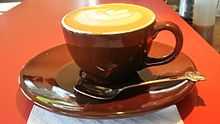Coffee cup

A coffee cup is a container that coffee and espresso-based drinks are served in. Coffee cups are typically made of glazed ceramic, and have a single handle for portability while the beverage is hot. Ceramic construction allows a beverage to be drunk while hot, providing insulation to the beverage, and quickly washed with cold water without fear of breakage, compared to typical glassware.
A coffee cup may also be a disposable cup in which hot beverages, including coffee, can be contained. Disposable coffee cups may be made out of paper or styrofoam. At coffee shops, paper cups are commonly are used to give beverages to customers on the go, usually with a coffee cup sleeve to provide insulation against heat transferred through the container.
After-dinnercoffee cups are often served with a small coffee spoon.
History
Coffee is originally drunk in mugs carved from bones dating back to the stone age. Other materials which have been used to make coffee cups are clay, wood, strengthened glass, metal, ceramic and porcelain.
Coffeehouse
Gibraltar or Cortado

The “Gibraltar” or cortado[1] is served in a 4oz rocks glass.
Demitasse
The Demitasse is a cup specially crafted for espresso. It is 2-3oz in capacity, and usually served on a saucer. The traditional macchiato - 2 shots of espresso and a dollop of foam is also served in the demitasse, on an accompanying saucer.
Cappuccino

The cappuccino is served in its own cup, a 6oz porcelain cup served on an accompanying saucer. The size of the cup reflects the traditional cappuccino, a drink with a 1:1:1 ratio. 2oz espresso, 2oz steamed milk, 2oz integrated foam.[2]

Cafe Drinkware
There are cafe cups in various sizes, standardized to reflect paper cup sizes. They are typically 8, 12, 16, and sometimes 20 oz. Slight variation is to be expected from coffeehouse to coffeehouse, but these sizes are the standard. These are the cups that house mochas, lattes, and other coffee drinks. These cups are also made of porcelain and shaped to encourage and aid in creating latte art.
Material
Porcelain allows for heat retention and crema preservation. However porcelain cools down quickly due to air bubbles in the cup.[3][4] Crema is the coffee foam at the top of a shot of espresso.[5] Preserving it in cups allows for latte art to occur in milk based espresso drinks.
Paper cups may be lined with wax or plastic to prevent leakage. The Anthora paper cup designed by Leslie Buck for the Sherri Cup Company in 1963 is recognized as an iconic part of New York City daily life.[6] [7]
Usually made of plastic, the first patent for a coffee cup lid design was filed in 1967, and focused on creating a tight seal between the cup and the lid to reduce leaking and a vent hole for minimized sloshing.[8][9][10] However, there was no opening for drinking, and the consumer would have to tear into the lid.[11] In 1986, the Solo Traveler lid was created and continues to be America’s most used and most recognizable coffee cup lid - it is in the Museum of Modern Art’s 2004 exhibit "Humble Masterpieces."[12][13] Louise Harpman, owner of the world’s largest collection of coffee cup lids, suggests that coffee cup lids “represent a major shift in American ‘to-go’ culture.”[14]
Polystyrene, better known under the trademarked brand name Styrofoam, is used mostly because of its insulating abilities. The use of polystyrene is controversial in coffee cups and other containers because it is non-biodegradable,[15][16] a major part of marine litter,[17] difficult to recycle, and has various health risks. It is banned as a food and drink container in several U.S. cities including Portland, Ore.; San Francisco, Calif.; and Amherst, Mass.[18] Many more cities are proposing banning the cups. The doughnut company and coffeehouse chain, Dunkin’ Donuts, has been criticized for continuing to use styrofoam cups.[19] The company has argued that there is no other material that is as insulated,[20] and has an official statement about their foam cups on their website.[21] However, they have begun phasing in doubled-walled paper cups designed to look like their signature foam cup.[22]
References
- ↑ Nguyen, Tien (2013-10-03). "Drink This Now: Cognoscenti Coffee's On-the-Menu Cortado | Squid Ink | Los Angeles | Los Angeles News and Events". LA Weekly. Retrieved 2014-05-20.
- ↑ "cappuccino: definition of cappuccino in Oxford dictionary (American English) (US)". Oxforddictionaries.com. 2014-05-14. Retrieved 2014-05-20.
- ↑ "Espresso Supply, Inc". Espressosupply.com. Retrieved 2014-05-20.
- ↑ "Espresso Machines & Espresso Grinders". Espresso Parts. Retrieved 2014-05-20.
- ↑
- ↑
- ↑
- ↑ Garber, Megan (2011-05-09). "The Rise of the Plastic, Disposable Coffee Cup Lid - Nicola Twilley". The Atlantic. Retrieved 2014-05-20.
- ↑ "Daily Coffee News by Roast Magazine – To-Go Cup Lid Makers Hoping to Capitalize On ‘Third Wave’ Success". Dailycoffeenews.com. 2014-05-02. Retrieved 2014-05-20.
- ↑ "Patent US3421681 - Cup and lid - Google Patents". Google.com. Retrieved 2014-05-20.
- ↑
- ↑ "Patent US4589569 - Lid for drinking cup - Google Patents". Google.com. 1983-10-24. Retrieved 2014-05-20.
- ↑ "Humble Masterpieces". MoMA. 2004-09-27. Retrieved 2014-05-20.
- ↑ "History, Travel, Arts, Science, People, Places | Smithsonian". Smithsonianmag.com. Retrieved 2014-05-20.
- ↑ "Drinking Coffee in a Styrofoam Cup? Pour It Out". Rodale News. Retrieved 2014-05-20.
- ↑ "Studies on photocatalytic degradation of polystyrene". Maney Online. Retrieved 2014-05-20.
- ↑
- ↑
- ↑
- ↑
- ↑
- ↑
| Wikimedia Commons has media related to Coffee cup. |